There are three major mattress topper types: memory foam; latex; and featherbed. If you’ve ever tried shopping for a mattress topper, whether online or in-store, then you will have come across these terms, but you might not feel totally clear on what they mean.
That’s where I come in. As H&G‘s resident Sleep Editor, I lead a team of expert testers in the search to find the world’s best mattress toppers. Together, we’ve tested 12 toppers, from plush pillow tops to firm foam models, so I’ve picked all the pros and cons of the different mattress topper types. I can tell you everything from how they feel to what they cost and where to buy them.
I’ve included commentary from my fellow mattress testers to give you the fullest possible picture of what it might be like to sleep on a particular topper. Follow my mattress topper buying rules and you won’t go far wrong.
Mattress topper types explained: the pros and cons
Admittedly, prices vary depending on the materials, but you should expend to spend somewhere between $150 and $450 to get a decent mattress topper in a Queen size. With that said, you could always try to save some money in the mattress sales.
Memory foam
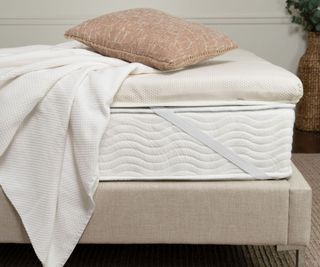
(Image credit: Saatva)
Best for: firm, inflexible mattresses; side sleepers and anyone who suffers from chronic pain
Pros: plush comfort; pressure relief; motion isolation
Cons: less suitable for hot sleepers; less durable
Before we begin, it always helps to define our terms. Memory foam, also known as viscoelastic foam, is a variant of polyurethane. It’s designed to respond to the shape, size, and temperature of the individual sleeper, molding to meet their needs.
How memory foam feels depends on the density of the foam, measured in pounds per cubic foot. All you need to know is that higher-density foam feels firm and solid (the sort of thing you find in a mattress base layer), while lower-density foam feels soft and cushy (more commonly found in mattress comfort layers). Don’t worry if you don’t recognize some of these words: you can always cross-reference against my mattress jargon buster.
Your average memory foam mattress topper is filled with lower-density foam, designed to soften up firm, inflexible mattresses. ‘As a side sleeper, I appreciate the contouring comfort and pressure relief of memory foam,’ says expert tester, Louise Oliphant. ‘It takes the weight off my hips to ease my lower back pain.’ Memory foam is known for its excellent motion isolation, so it’s a good choice for couples and light sleepers.
There’s an old adage that memory foam traps heat. That’s true of earlier iterations, but modern manufacturers have found plenty of ways to incorporate cooling technology into their memory foam mattress toppers.
The blessing and the curse of memory foam is its propensity to develop indents and impressions. That’s what gives you the feeling of body contouring, but it also ages the material. You can’t expect to get more than a few good years out of a memory foam mattress topper, while latex products could last you as long as 20 years.
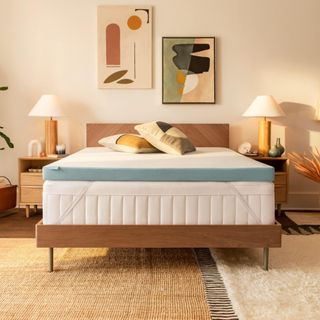
Tempur-Adapt Tempur-Topper
This is our reigning champion for the title of ‘best mattress topper’, with high scores across the board for pressure relief, thermoregulation, motion isolation, and edge support. Sometimes, I hesitate to recommend the Tempur-Adapt Tempur-Topper because it’s so expensive. I feel much more confident with our 40% discount: use TOPPERS40 to save.
You can find more detail in our Tempur-Adapt Tempur-Topper review.
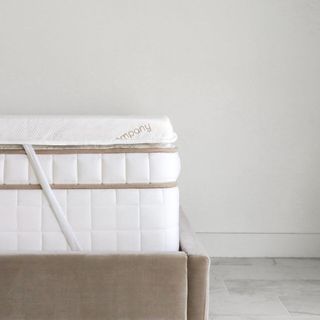
Saatva Graphite Mattress Topper
‘This mattress topper made an immediate improvement to the look and feel of my bed,’ says expert tester Kaitlin Madden. As a hot sleeper, Kaitlin appreciated the thermal conductivity of graphite, which carried excess body heat away from her body and out of her bed to keep her cool in the summer.
You can find more detail in our Saatva Graphite Mattress Topper review.
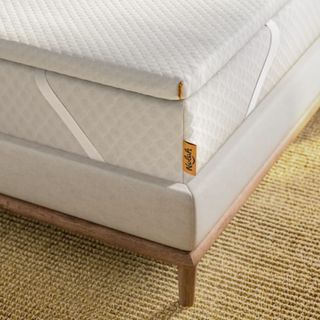
Most memory foam mattress toppers feel soft and squishy, but the Nolah Mattress Topper is firm and supportive: just the thing to toughen up a sagging mattress. The perforations throughout the AirFoam help to keep things cool, and expert tester Jamie Davis Smith still raves about the edge support. Just make sure you wait 24 hours to sleep on it until the smell of the mattress off-gassing has dissipated.
You can find more detail in our Nolah Mattress Topper review.
Latex
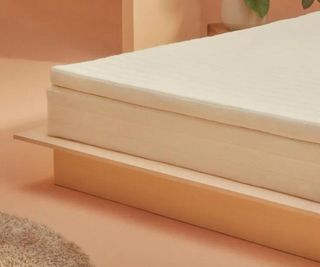
(Image credit: Earthfoam)
Best for: eco-conscious shoppers
Pros: breathable; durable; supportive
Cons: expensive; heavy
There are two methods of producing latex. The Dunlop method involves vulcanization: hardening the latex through a combination of heat and sulfur. This makes it stronger and more supportive. The Talalay method involves freezing the latex into a mold, then infusing it with carbon dioxide to create little air bubbles. This makes it springier and more responsive.
How your latex mattress topper feels depends on whether it’s filled with Dunlop or Talalay latex. I’d use Dunlop latex to lend more support to a sagging mattress and Talalay latex to take the edge of an overly firm mattress. Both types of latex are highly breathable and ultra-durable. Take good care of your latex and it could last you as long as 20 years. That’s why it’s so good to sleep on latex.
There are two major downsides to using latex in your mattress topper: the weight and the cost. You might want to ask a friend or family member to help you unbox your latex mattress topper and get it onto the bed. The cost is unavoidable, especially of you go organic, but that’s the price you have to pay for sustainable materials.
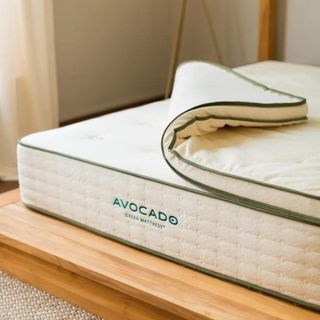
Avocado Organic Latex Mattress Topper
The Avocado Organic Latex Mattress Topper recently relaunched in two heights and two firmness levels to suit every sleep style. I’d recommend the Plush Talalay latex topper for anyone who sleeps on their side or suffers with aches and pains, and the Medium Dunlop topper for anyone whose mattress needs a little more support.
You can find more detail in our Avocado Organic Latex Mattress Topper review.

Turmerry Latex Mattress Topper
‘The bouncy feel of latex is responsive and distinct from memory foam,’ says expert tester Jamie Davis Smith: ‘I actually found it far more comfortable. I never woke up with aches or pains. In fact, the topper arrived just as a heatwave was hitting, and it kept me cool on sweltering nights. I think it’s one of the best mattress toppers on the market.’
You can find more detail in our Turmerry Latex Mattress Topper review.
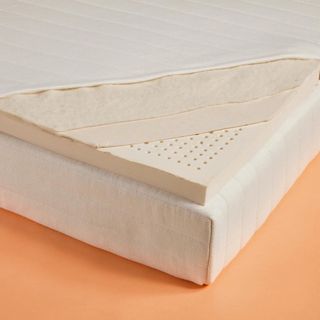
Earthfoam Mattress Topper
‘Right before I started testing the Earthfoam Mattress Topper, I was sleeping on a five-inch memory foam topper, and I couldn’t wait to get rid of it,’ says expert tester Louise Oliphant. ‘I found that this organic latex layer has more bounce and less depth than memory foam, with far superior cooling and sustainability stats.’
You can find more detail in our Earthfoam Mattress Topper review.
Feather and down
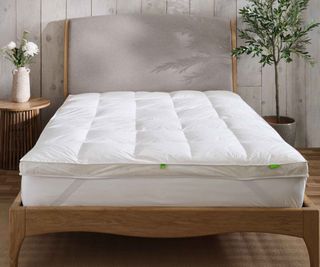
(Image credit: Scooms)
Best for: pillowy comfort
Pros: soft and squishy; great for side sleepers
Cons: not especially supportive
A feather and down mattress topper, also known as a featherbed, is what you get when you cross a comforter with a mattress topper. These thick, fluffy layers feel soft and squishy, offering plenty of comfort, but little support.
I might layer a feather and down mattress topper over a firm, inflexible mattress. If you’re a side sleeper, then you’ll appreciate the extra bit of give to contour around your curves and keep your spine straight. If you sleep on your back or your stomach, you need something more supportive.
Featherbed mattress toppers tend to keep cool, and they’re relatively inexpensive, but they’re a little high-maintenance. You’ll need to give them a good shake every so often to fluff up the feathers and smooth out any lumps and bumps. It goes without saying, but if you’re allergic to feathers or you prefer not to purchase animal products, then you’ll need to look for another type of mattress topper.
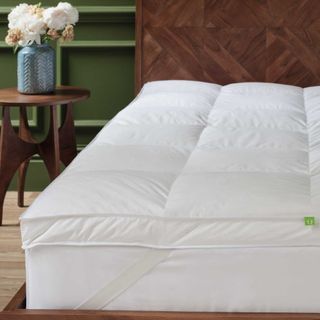
Scooms Hungarian Goose Feather & Down Mattress Topper
This featherbed features a baffle box construction to keep each cluster of down in place. This should reduce the appearance of lumps and bumps. The whole thing is wrapped in tight-weave cotton to keep the feathers in and the dust mites out.
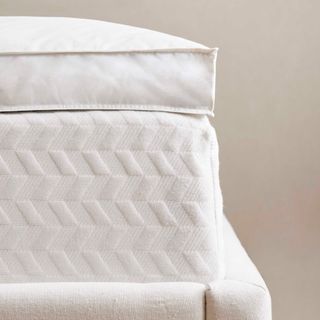
Quince Luxe Downtop Featherbed Mattress Topper
This featherbed boasts a 4.7 average star rating from 72 reviews. ‘It’s extremely lush and comfy,’ says one recent reviewer. ‘I didn’t know if it would be too squishy and too soft but I’ve found it very comfortable. I’m eight months pregnant and I’ve definitely been sleeping better. The only thing is that it gets hot, as down tends to trap heat.’
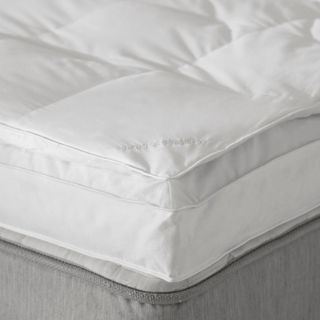
Boll & Branch Cloud Cover Featherbed
This feather bed is filled with responsibly sourced down, as authenticated by the RDS, and wrapped in organic cotton. It’s a good option for eco-conscious sleepers in need of some plush comfort. The top layer is filled with down for natural loft and the bottom chamber is filled with feathers for more support.
FAQs
Will a mattress topper help?
If you’re struggling to sleep on a mattress that feels too firm or too soft, then a mattress topper could help to change the look and feel of the mattress to make it more comfortable for you.
There is a mattress topper type to meet every sleep need. I’m talking cooling mattress toppers for hot sleepers, firm mattress toppers for back and stomach sleepers, and plush pillow tops for side sleepers. Follow my mattress topper buying rules and you won’t go far wrong.
However, if your mattress is past its prime, then a mattress topper won’t help. The only way to fix a sagging mattress is to return it to the manufacturer for repair.
Can a mattress topper be washed?
As H&G’s resident sleep writer, I’m often asked: ‘can a mattress topper be washed?’ My answer depends on the mattress topper type. Memory foam cannot be washed in the washing machine and must be spot-cleaned. Featherbeds, as well as polyester or cotton toppers, can go in the washing machine, as long as you use a gentle detergent. If in doubt, always check the laundry symbols of the care label.
Even the best mattress topper should only ever be a short-term fix. If you’ve had your mattress for seven years or longer, and you’re noticing sagging or loss of support, then your money would be better spent on the best mattress. I’ve outlined the pros and cons of all the major mattress types for your consideration.
When shopping for a mattress topper, you will encounter three main types: memory foam, latex, and featherbed. Understanding the differences between these types can be confusing, but as the Sleep Editor at H&G, I have tested various mattress toppers and can provide insights into their pros and cons.
With a team of expert testers, we have evaluated 12 different mattress toppers, ranging from plush pillow tops to firm foam models. I have gathered all the necessary information on how they feel, their cost, and where to purchase them.
By incorporating feedback from our testers, I aim to give you a comprehensive understanding of each mattress topper type. Follow my tips on purchasing a mattress topper, and you will make an informed decision.
Mattress topper types explained: the pros and cons
Prices for mattress toppers can vary based on the materials used, but a decent Queen-size topper typically ranges from $150 to $450. Keep an eye out for discounts during mattress sales to save some money.
Memory foam

(Image credit: Saatva)
Best for: firm, inflexible mattresses; side sleepers; individuals with chronic pain
Pros: plush comfort; pressure relief; motion isolation
Cons: less suitable for hot sleepers; less durable
Memory foam, also known as viscoelastic foam, responds to the sleeper’s shape, size, and temperature, providing personalized comfort. The density of the foam determines its firmness, with lower-density foam offering a softer, cushier feel ideal for adding comfort to firm mattresses.
Testers have praised memory foam for its contouring comfort, pressure relief, and motion isolation, making it a popular choice for side sleepers and couples. Modern memory foam toppers incorporate cooling technology to address heat retention issues.
While memory foam provides excellent comfort, it tends to develop indents over time, limiting its longevity compared to latex products.
Latex

(Image credit: Earthfoam)
Best for: eco-conscious shoppers
Pros: breathable; durable; supportive
Cons: expensive; heavy
Latex mattress toppers, produced through the Dunlop or Talalay method, offer varying levels of support and responsiveness. While Dunlop latex provides firmness and support, Talalay latex offers a springier feel.
Both types of latex are breathable and durable, with proper care potentially lasting up to 20 years. However, latex toppers are heavier and pricier compared to other options.
Feather and down

(Image credit: Scooms)
Best for: pillowy comfort
Pros: soft and squishy; great for side sleepers
Cons: not especially supportive
Feather and down mattress toppers, known as featherbeds, offer a plush and comfortable feel but lack substantial support. Ideal for side sleepers, these toppers require occasional fluffing to maintain their shape.
While featherbeds are cooling and relatively affordable, they may not be suitable for those allergic to feathers or seeking more support.
FAQs
Will a mattress topper help?
If your mattress feels too firm or too soft, a mattress topper can adjust its comfort level to better suit your needs. Different types of toppers cater to various sleep preferences, offering solutions for hot sleepers, back/stomach sleepers, and side sleepers.
However, if your mattress is old and sagging, a topper may not provide a lasting solution. In such cases, investing in a new mattress is recommended.
Can a mattress topper be washed?
The washability of a mattress topper depends on its material. Memory foam toppers cannot be machine washed and require spot cleaning, while featherbeds and other fabric-based toppers can be washed with mild detergent. Always refer to the care label for specific washing instructions.
While a mattress topper can enhance comfort temporarily, replacing an old mattress is essential for long-term support. Consider the advantages and disadvantages of each mattress type before making a decision.
